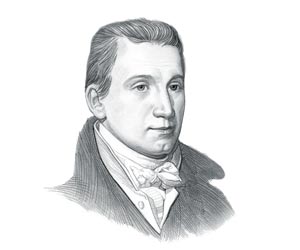|
The legislation,
which became known as the Missouri Compromise, admitted Missouri
as a slave state and Maine as a non-slave state at the
same time, retaining the balance between slave and free
states.
The
Missouri Compromise of
1820 for kids:
Background History
It was a time of
great change and movement in the United States. The movement west
was at its height in 1817. During the years 1816--19, four states
were admitted to the Union. The states were Indiana (1816),
Mississippi (1817), Illinois (1818) and Alabama (1819). The request
then came in 1819 from the state of Missouri to also be admitted to
the union quickly followed in 1820 by the people of Maine who asked
Congress to admit them as the state of Maine.
Missouri Compromise of 1820 for kids: Objections to the admission of Missouri
The Missouri Compromise
became necessary because many Northerners opposed the
admission of Missouri because the settlers of the proposed state
were slaveholders. This would mean that Missouri would be another
slave state in the union. People in the North were totally against
the admission of any more slave states. Every state, north of
Maryland, had either put an end to slavery or adopted a plan by
which slavery would gradually be abolished.
Missouri Compromise of 1820 for kids: The Northwest Ordinance
Slavery had been excluded from
the Northwest by the
Northwest Ordinance of 1787. The Northwest
Ordinance of 1787 included a clause that stated that after the year
1800 there shall be neither slavery nor involuntary servitude in any
of new states in the areas covering the Lakes to the Ohio and from
the Mississippi to Pennsylvania. Slavery had therefore ceased to be
a vital institution north of Maryland and Kentucky.
Missouri Compromise of 1820 for kids: Louisiana
Louisiana had been admitted as a
slave state in 1812, but its admission had been provided for in the
treaty for the purchase of Louisiana from France.
The Louisiana Territory was
broken into smaller administration areas, and the territories passed
slavery laws similar to those in the southern states.
Missouri Compromise of 1820: The Southerners Viewpoint
The Southerners felt equally as
strongly as the Northerners on the issue of slavery. They asserted
that their slaves were their property, and that they had a perfect
right to take their property with them and settle on new lands
belonging to the nation. The Southerners asserted that because they
had founded a slave state, it was only right that the state should
be admitted to the Union.
What was the Purpose of the
Missouri Compromise?
Congress was faced with the
question of the
extension of slavery into new territories. The opposing sides were
never going to agree on the issue of slavery. The Senate was equally
divided between the Slave states and the Free states. However, the
majority of the House of Representatives were from the free states.
And this number was increasing. If the free states were to also
obtain a
majority in the Senate the Southerners would lose all
control of the government. The Southerners would therefore not
consent to the admission of Maine as a free state unless at the same
time Missouri was admitted as a slave state.
The purpose of the Missouri Compromise
was to keep a balance between the number of slave states and the
number of free states in the Union.
Who Proposed the
Missouri Compromise of 1820?
The
idea of the Missouri Compromise,
which proposed to limit slavery above the southern border of
Missouri, is credited to Senator Jesse B. Thomas of Illinois
(1806-1850) but was strongly supported by Henry Clay (1777 – 1852).
What were the Terms of the
Missouri Compromise?
The
terms of the Missouri Compromise of 1820 were:
-
Maine and
Missouri were both admitted to the union
-
Missouri
was admitted as a slave state
-
Maine was
admitted as a non-slave state
-
The Missouri Compromise specified
that all of the Louisiana purchase north of the southern
boundary of Missouri, with the single exception of the state of
Missouri, should be free soil forever
-
Congress
also passed an amendment that drew an imaginary line across the
former Louisiana Territory, establishing a boundary between free
and slave regions that remained the law of the land until it was
negated by the 1854 Kansas-Nebraska Act
-
The
negation of the act was one of the
Causes of the Civil War
Why was the
Missouri Compromise Important?
The Missouri Compromise
of 1820
was important because it delayed the inevitable conflict over
slavery for 25 years which erupted in the
American Civil war (1861-1865) - refer to
Map of
Slave
states and Free states.
The Missouri Compromise of 1820 and the 1854 Kansas-Nebraska Act
The
terms of the Missouri Compromise of 1820 were contravened in
the Kansas-Nebraska Act, which
through the
doctrine of
Popular Sovereignty, effectively allowing the settlers in two new territories
of Kansas and Nebraska the right to say whether they should be a
free state or a slave state. The opponents of the
1854 Kansas-Nebraska Act formed the
Republican Party.
The
Kansas-Nebraska Act and the doctrine of
Popular Sovereignty and
slavery divided the country and pointed the nation towards civil
war.
|

